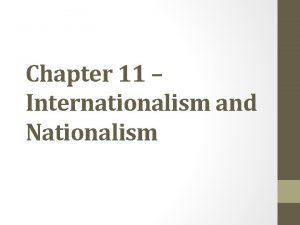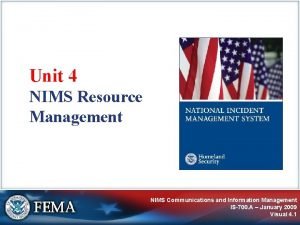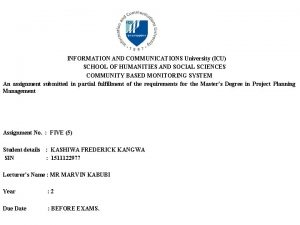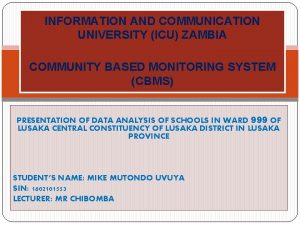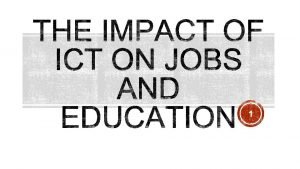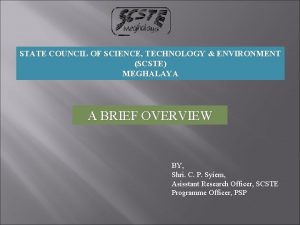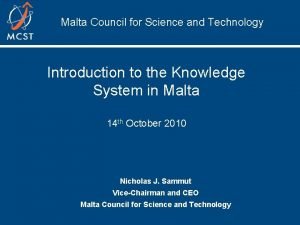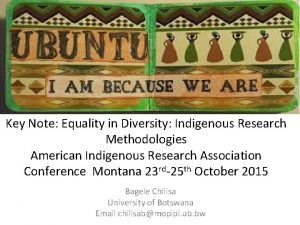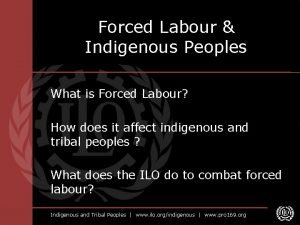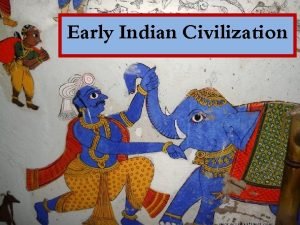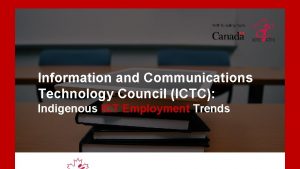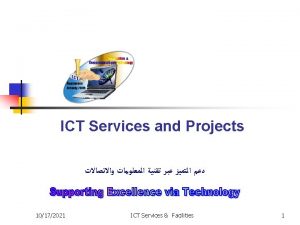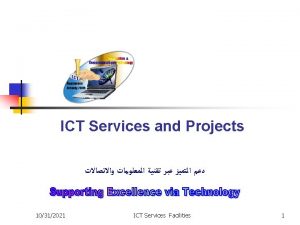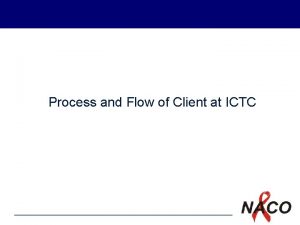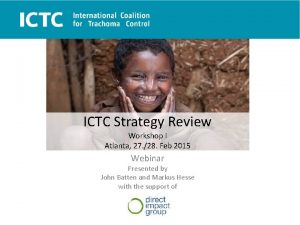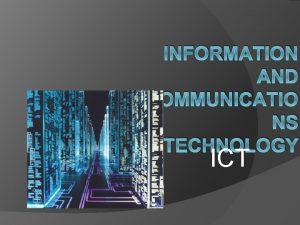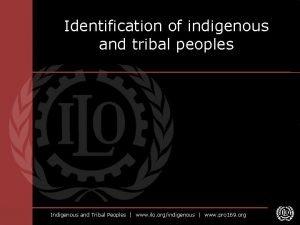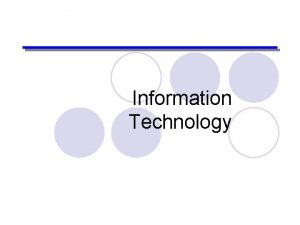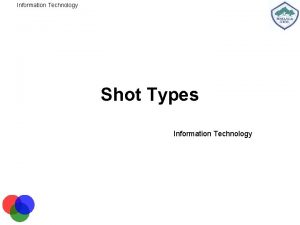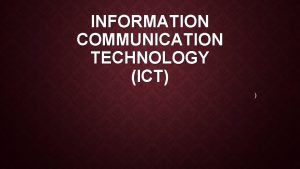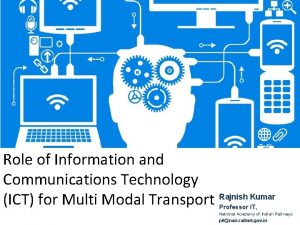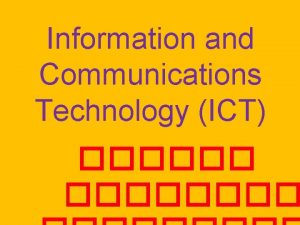Information and Communications Technology Council ICTC Indigenous ICT


















- Slides: 18

Information and Communications Technology Council (ICTC): Indigenous ICT Employment Trends

Where we come from: ICTC History ICTC is a large network of industry, educational institutions, and policy makers representing the digital economy in Canada. As an independent and neutral policy advisor to business and governments across Canada, ICTC remains an authoritative source of technology, economic information, labour market research and is a leader in capacity building initiatives for that impact Canada’s digital economy. 2

The Digital Labour Market Where does Canada fit internationally?

The Digital Labour Market, Our Motivation Canada is expected to play an important role in the $3. 8 trillion global information and communications technology (ICT) economy. Focusing on traditional areas of software services, as well as emerging areas such; ● Advanced manufacturing ● Intelligent retail ● Artificial intelligence ● Blockchain ● 5 G. 4

The Digital Labour Market, Our Climate Despite the importance of technology adoption to business sector innovation and competitiveness, Canada’s adoption rate remains low compared to our international counterparts. This lack of skilled technology workers results in a direct lack of support to innovative fields. This missing ICT labour market can negatively directly impact rural and urban; ● Manufacturing ● Finance ● Healthcare Despite this opportunity and need, Canada is experiencing a shortage of skilled ICT talent, largely in relation to demographic shifts and an insufficient volume of youth in the post-secondary supply pipeline. 5

Digital Labour Market; Our Indigenous Future The ability to engage our Indigenous peoples will be critical in addressing these shortages. However, the benefits of engaging Indigenous peoples in the ICT and STEM labour force extend far beyond labour shortages. ICT adoption for Indigenous communities has the potential to shape a generation of youth that respond to challenges and integrate into tomorrow’s digital economy in an effective and sustainable manner. This ultimately becomes a net economic benefit for Indigenous communities and Canada as a whole. 6

Indigenous students are constantly learning to walk in two different worlds - it is often said they walk with a moccasin on one foot, and a running shoe on the other; for this reason, it is critically important that we provide culturally responsive pedagogy that teaches them the skills needed to be successful in a technology-driven world. . Many First Nations rely on external businesses to service various aspects of the community. . . while the goal. . . is to protect their inherent rights through self-governance and autonomy - to provide services for the community from the community. With digital competencies, students will be able to contribute to the implementation of needed services in their communities. . . enhancing the level of self-governance and improving the well-being and quality of life of those in the community. 7

In 2016, Indigenous peoples. . . ● ● Had more than 10 k (1. 2%) of the Indigenous population employed in ICT jobs in Canada Had an ICT unemployment rate was 2. 8% (overall ICT unemployment rate of 2. 6%) Had an overall Indigenous unemployment rate of 12. 3% Positive growth trend identified since 2008 8

Indigenous ICT Professionals: ● ● ● 31. 4% of all Indigenous ICT professionals in Canada are employed in the ICT sector. 47% of Indigenous ICT professionals are First Nations, 47% are Métis, 2% are Inuit, 2% are from another Indigenous background and 0. 45% are from multiple Indigenous creeds. Indigenous ICT professionals are younger than the non-Indigenous ICT workforce: 8. 2% of the Indigenous ICT workforce is between 15 to 24 years of age and 29. 3% is between 25 to 34 years of age. Women represent about 27% of the Indigenous ICT workforce. About one-third have a university degree at the Bachelor level and 36. 9% possess a college or CEGEP diploma. 9 9

So, What Does This All Mean? As the quest for talent intensifies, our success in sustaining the development of a competitive and innovative Indigenous population depends on how organizations, education and government leverage opportunities for Indigenous people, while encouraging community based, and our national digital economy. Additionally, fostering a strong relationship with Indigenous communities is a primary ingredient in to acknowledging past traumas and the marginalization that Indigenous peoples have experienced in the labour market and our society. Implementing policies that allow us to foster an Indigenous ICT talent pool in a collaborative and inclusive way with Indigenous communities themselves is a fundamental process in securing our collective social and economic prosperity. 10 10

Where We’re Going: Our Digital Focus Industry and associations, in collaboration with Indigenous communities should work together to build awareness of ICT use, while brainstorming ideas on how to incorporate digital technologies into the community and classroom. 11

Suggestive Paths Forward: Opportunities To Explore Industry Champions: Post-Secondary Involvement: Support For Teachers & Admin Industry, educators, and associations should work with Indigenous communities to highlight the work of Indigenous role models employed in ICT, especially to Indigenous youth. Media, government and industry coverage displaying success stories of Indigenous workers in ICT and STEM professions can help to foster increased awareness and enhanced understanding of the career opportunities in the digital economy. Educators at the post-secondary Government at all levels and industry should increase the amount of support available to teachers and school administration staff, in order to assist them in integrating ICT and STEM into curriculums that are culturally appropriate. level should improve the access to mentorship and coaching programs, writing courses, and academic advising at post-secondary institutions, to support Indigenous students throughout their university and college programs and improve This should include. . . their educational outcomes. 12

What Can Be Changed; For Education ● Ensuring funding provided for on-reserve students, is equal to non-Indigenous students. ● Equipping teachers with the resources, materials, and professional development opportunities to learn how to integrate ICT and STEM content into lesson plans in culturally relevant and appropriate ways for Indigenous youth. ● Educating teachers, without an Indigenous background, who will be teaching in Indigenous communities, Indigenous culture and the pedagogical methods that best suit Indigenous learners. 13

What ICTC Can Do; For Education Cyber Activity Days: These activity days are designed around an individual school or community to get youth interested in code, cyber-security and digital citizenship. Focus On IT (FIT) My. FIT (Focus On IT) Focus on IT (FIT), Middle Years FIT (My. FIT): The FIT/My. FIT program is a nationally recognized certificate process designed for students interested in Digital Business Challenges gaining real-world skills during their elementary and secondary school experience. FIT allows educators to merge real-world and workplace challenges into the classroom, following a set of easy, curriculum mapped Cyber. Titan pathways found within your province. 14 14 14

What ICTC Can Do; For Education Cyber. Titan: This team and competition based program seeks to promote education and awareness in technology education and foster excellence in students pursuing careers in cyber security or other science, technology, engineering, and mathematics (STEM) areas. Focus On IT (FIT) My. FIT (Focus On IT) Digital Business Challenges: Digital Business Challenges Either in part with the Focus on IT (FIT) program, or individually, communities and/or schools are matched with an organization hoping to solve a real-world digital challenge. Students are tasked with developing a Cyber. Titan proposal to help understand solve the unique digital scenario. 15 15 15

How We: Move Forward Indigenous ICT programs that have the highest success rates are those where the community leads or collaborates in the decision making process. With that said, nonprofits can assist by acting as important partners, collaborating between communities and government. Also critical to the success of any such initiative is deep stakeholder collaboration — that is, government at all levels, industry, associations, educators, and individuals, and most importantly, Indigenous communities - working together. Through cooperation, collaboration, as well as idea and culture -sharing, stakeholders can work together to build trust with Indigenous communities, shape policies that create lasting benefits, and ultimately, move us all forward on the path towards reconciliation. 16 16

Thank You! Any questions? You can find out more at: www. focusit. ca 17

Credits ● ● Design theme: Slides Carnival: Olivia Presentation Theme Research & Content: ICTC’s “Digital Economy Talent Supply: Indigenous Peoples of Canada” 2017 - https: //www. ictc-ctic. ca/wpcontent/uploads/2017/06/Indigenous_Supply_ICTC_FINAL_ENG. pdf Focuson. IT: http: //www. focusit. ca/ Cyber. Titan: https: //www. cybertitan. ca/ 18
 World council of indigenous peoples
World council of indigenous peoples Nims communications and information management
Nims communications and information management List of lecturers at icu zambia
List of lecturers at icu zambia Information and communication university
Information and communication university What is information
What is information Aboriginal signs
Aboriginal signs State council of science and technology
State council of science and technology Technology and maintenance council
Technology and maintenance council Malta council for science and technology
Malta council for science and technology Indigenous axiology
Indigenous axiology Mi'kmaq colours
Mi'kmaq colours Herman michell
Herman michell What is indigenous research
What is indigenous research What is indigenous research
What is indigenous research Indigenous knowledge systems tok
Indigenous knowledge systems tok Indigenous name for forced labour
Indigenous name for forced labour Indigenous aryans
Indigenous aryans Dana alotaibi death
Dana alotaibi death Simple machines used by first nations
Simple machines used by first nations
